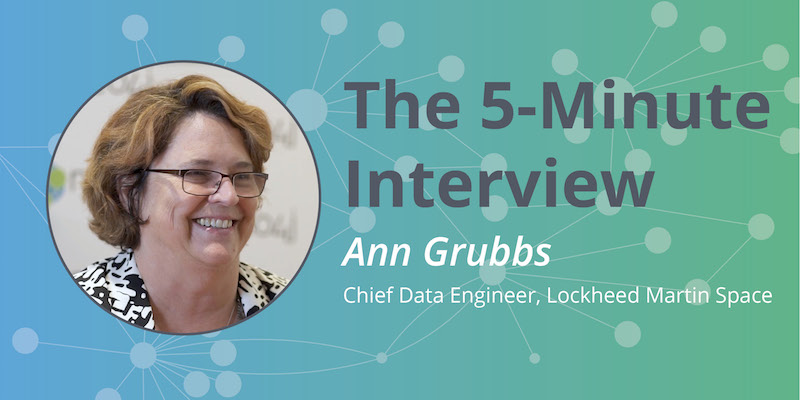Lockheed Martin Space builds satellites, following the entire product lifecycle, from proposals to engineering and design to procurement and manufacturing, right through operations, aligning the satellites in space.
Connecting all of the data for each of the thousands of parts, across data silos, is what Ann Grubbs, Chief Data Engineer, refers to as mapping their product’s DNA.
In this week’s five-minute interview (conducted at GraphConnect 2018 in NYC), we discuss why Lockheed Martin Space chose Neo4j for its master data management initiative.
How do you use Neo4j?
Ann Grubbs: We are using Neo4j as a master data management tool. We’re trying to get our product DNA laid out so that we can use that as a reference for other applications and for analytics and to understand how our business works.
What made you choose Neo4j?
Grubbs: At the time when we got started, we had a particular problem. That problem looked like a graph on a whiteboard so we started researching products. We ended up reviewing Neo4j and OrientDB and looked at their different capabilities and Neo4j was far and away the leader.
What have been the most surprising results you have seen from Neo4j?
Grubbs: We had a particular case where we imported all the parts from a very complicated spacecraft to try to determine what was the most important part in that spacecraft. It turned out that a tube of adhesive had the most influence. The capability to be able to see the level of the influence within one domain or against other domains is surprising.
If you could go back to when you started using graphs, what would you change?
Grubbs: I’d get help first, right away, and hire in some experts. We thought we knew how to use it, but a graph database is very different from any other database. After we got some training, we decided that we needed some additional expertise.
We did learn that we had the flexibility to be able to trash the whole thing and start over. As long as we’re really careful about scripting up our data loads or the processes to run our ETL, that’s been really an advantage. Because Neo4j is schema-less, we just trash the whole thing and start over.
What do you think is in store for the future of graphs?
Grubbs: I think more and more companies are going to see the value of the connection of the data. Right now, the value on data is becoming key at our company. How can we capitalize on all this data? Can we monetize this data? Data is meaningless if you don’t know how to connect it. I think interest in graph technology is going to explode.
What is your favorite aspect of working with Neo4j?
Grubbs: I think it’s really great to be able to work with a small company that you can reach into and get the help and expertise you need. I appreciate that. We work with big companies all the time, like SAP and Oracle, and it’s really painful to find your way around to the person who knows the answer. I can just call my rep, Jason, and he finds me someone who knows the right answer.
Want to share about your Neo4j project in a future 5-Minute Interview? Drop us a line at content@neo4j.com
Download this white paper, The Top 5 Use Cases of Graph Databases, and discover how to tap into the power of graphs for the connected enterprise.
Read the White Paper




